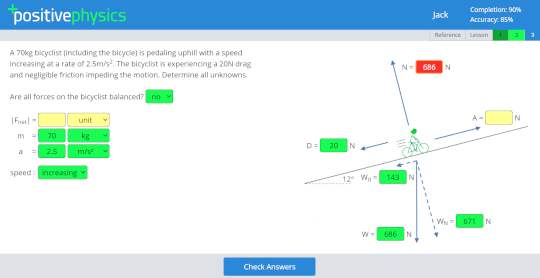High school science instructor Jack Replinger originally created Positive Physics as an online resource for physics classes he was teaching and has since developed it to include complete coursework (without lab work) for physics. The website also offers a chemistry course taught in the same fashion by Marianne Olson, and an engineering course is in the works. Annual subscriptions give students access to both courses as well as engineering lessons as they become available.
Both courses combine video instruction with plenty of questions that require students to apply the concepts. Some lessons review vocabulary words since understanding the vocabulary is vital for both subjects.
In the videos, Replinger and Olson provide voice-over instruction along with images, math, and other lesson content via electronic whiteboard. Beneath the videos, the program displays the main idea(s) for that lesson, new equations and rules to learn, and helpful tips.
Course content is presented in several units—30 for physics and 24 for chemistry at this point. Two units in each course are dedicated to semester and final reviews to prepare students to take the included assessments. Both courses cover topics typical of high school courses, although oxidation-reduction reactions are missing from the chemistry course. That content and more is supposed to be added for chemistry over the next year.
All units are divided into several lessons, each beginning with a video. The video is followed by a series of questions, presented one at a time. Answers are checked immediately, and the program shows scores for both completion and accuracy. Accuracy is based on answers submitted the first time. However, students can try again until they get the correct answer, and the completion score reflects the percentage of questions eventually answered correctly.
Students might complete one or a few lessons per day, depending upon the speed at which they work. The reviews might be completed over a few days.
Math is used frequently throughout both courses. Replinger and Olson provide some explanations for the math skills, along with reference pages to help students who are weak in math. For example, Chemistry begins with unit conversions, and Olson teaches strategies for making conversions and retaining proper labeling of the units.
However, students will be applying advanced mathematical concepts and using math symbols that might be unfamiliar to them. For instance, the first lesson in Physics begins with time/rate/distance problems presented in terms of velocity (v) displacement (Δx), and time (t). The equation for velocity is then expressed as Δx = v t. It's important for students to understand that the math instruction and the wealth of practice problems are not there for their own sake; they are essential for helping students grasp the physical relationships.
In addition to the lessons and the assessments, students also have access to Extra Practice problems for each lesson. These are scored only at the end of a set, although students can still try again to correct those they missed. The goal is to prepare students for the course assessments as well as Advanced Placement® exams, so figuring out where they went wrong is an important step. Replinger has used the Physics course to help prepare students for the Physics I and Physics II Advanced Placement exams. He explained to me,
The teachers whose students have been really successful on the AP tests use Positive Physics to make sure students are really solid on the basics, then use released AP exams. (A common mistake is jumping straight to the AP practice, which is very technical, without a strong foundation.)
Positive Physics is still working on the material to prepare students for the AP Chemistry and AP Physics C exams.
The teacher dashboard allows teachers to keep track of student progress and see exactly which parts of problems are missed. This makes it easy to identify concepts students might not understand. The teacher also has other controls such as those for assigning particular activities and selecting the number of problems to be displayed in Extra Practice. Of particular interest might be the option to print out pages with the problems for students to solve off-screen. (Teachers have to check those problems themselves.)
Lab Options
The lack of lab work will be an issue for some students. Quality Science Labs’ QSL Physics Lab kit and companion lab manual and their MicroChem Kit (2nd edition) with its included manual will both definitely be suitable for high school students, providing appropriately challenging activities. If you want less-challenging activities, you might use the Kosmos and Thames kits for chemistry, either Chem C1000 or Chem C2000, the Kosmos and Thames Physics Pro: Advanced Physics Kit, or Home Science Tools’ Complete Introduction to Physics kit. Aside from the QSL kits, all other kits mentioned here present experiments at lower levels of difficulty than what students would experience in a lab class, but some families might find them sufficient.
Summary
The Positive Physics website is well-designed and simple to use, so these courses make it easy for students to learn physics and chemistry independently with a high level of accountability.












